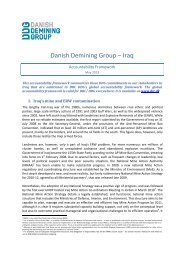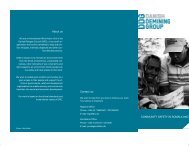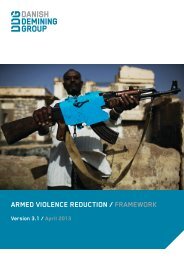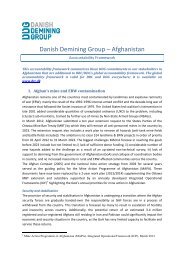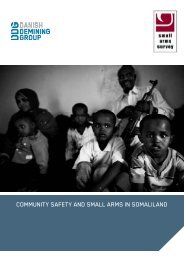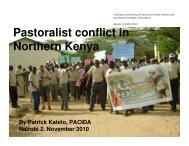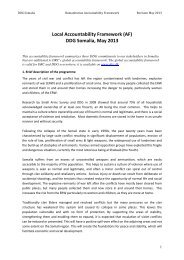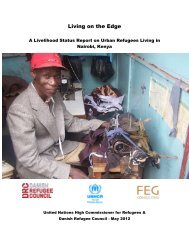Read the full report - Danish Refugee Council
Read the full report - Danish Refugee Council
Read the full report - Danish Refugee Council
Create successful ePaper yourself
Turn your PDF publications into a flip-book with our unique Google optimized e-Paper software.
CASH PROGRAMME REVIEW FOR IDPs IN KABUL INFORMAL SETTLEMENTS 473. Determining <strong>the</strong> size of <strong>the</strong> grantThe amount of <strong>the</strong> grant varies according to intervention modalities and purposes. In <strong>the</strong> perspectiveof addressing (i) needs during <strong>the</strong> winter, and (ii) a recovery interventions, <strong>the</strong> following differentdeterminants can be taken into account:Previous or current assistance to <strong>the</strong> target households. Given <strong>the</strong> high degree of assistanceprovided in <strong>the</strong> KIS, specific attention will need to be provided to <strong>the</strong> type of assistanceoffered and received by households in each of <strong>the</strong> targeted camps, to assess <strong>the</strong> preferredobjective of <strong>the</strong> grant and tailor its size accordingly. If assisted in <strong>the</strong> form of food or nonfooditems, cash assistance can be directed towards o<strong>the</strong>r needs, such as small-scaleinvestments as working capital, repayment of debts, improving <strong>the</strong> consumption basket, etc.Cash grants can be calculated to be smaller and complementary to existing assistance, orcome as a helping hand after o<strong>the</strong>r forms of assistance.Actual needs: Given <strong>the</strong> unstable nature of incomes noticed through our survey, basinggrants on a <strong>the</strong>oretical average monthly basket of basic necessities (food, fuel, clothing,water etc.) might be challenging, and needs to take into consideration seasonal variationsand o<strong>the</strong>r forms of assistance. An alternative solution is to base <strong>the</strong> grant on <strong>the</strong> averagefood consumption and <strong>the</strong> ability of targeted communities to meet <strong>the</strong>ir needs on <strong>the</strong>ir own.The majority (40%) of surveyed households in our sample explained <strong>the</strong>y often have problemsatisfying <strong>the</strong>ir food needs, and 31% to encounter difficulties 3 to 6 times a month, mainlyrelying on debts. In such cases, grants adapted to <strong>the</strong> food basket to cover all <strong>the</strong> needs ofbeneficiaries might need to be considered, especially in times of acute shortage like winter.Cash grants or vouchers provided to households can help complement provision of in-kinddistribution of staples, or be redirected towards o<strong>the</strong>r urgent needs- such as repayment ofdebts. The initial phase is to get exact information on daily food consumption throughhousehold surveys, complemented by a market micro-surveillance and pricing.Size of households: <strong>the</strong> amount of grants does not need to be “one-size-fits-all” and can varyaccording to <strong>the</strong> size of <strong>the</strong> households and an evaluation of <strong>the</strong>ir needs, requiring closemonitoring to avoid artificial inflation of household numbers.Inflation rate and market prices in <strong>the</strong> local market, to adapt <strong>the</strong> size of grants accordinglyand adjust <strong>the</strong> actual purchasing power of beneficiary households. A fixed amount of cashwill not have <strong>the</strong> same purchasing power in pre and post inflation periods, <strong>the</strong> purchasingpower of beneficiaries might be affected and <strong>the</strong> outcomes of <strong>the</strong> programme diverted.Determining <strong>the</strong> amount of regular cash transfers should be done in close coordination with NGOs ina nearby area. Different cash grants or methods of implementation in a limited geographical spacecan create conflicts and competition between programmes.Determining <strong>the</strong> fair value of <strong>the</strong> grant with ACF Afghanistan.The amount of cash distributed by ACF is based on <strong>the</strong> average one-month foodconsumption of a household of 7 members, calculated based on a micro-market surveillanceand price assessment.The wages for CFW have to be 25% under <strong>the</strong> labour rate in order not to compete with <strong>the</strong>labour environment and create artificial disruptment of <strong>the</strong> labour market. This practice isnotably different from that of PIN, which fixes its wages at <strong>the</strong> same level as <strong>the</strong> labour rate,based on <strong>the</strong> observation that <strong>the</strong> labour market is not functional in post-disaster situationsand that cash-for-work creates a temporary but necessary income generation activity forbeneficiary households. A major point underlined by ACF was <strong>the</strong> need for coordinationbetween agencies on <strong>the</strong> rate of wages in order to avoid tensions between communities andagainst NGOs due to differences in wages in neighbouring areas: “we had to conform towhat <strong>the</strong> community was used to. We have future CFW programmes pipelined for 2013, andwe budgeted 300 per day, as opposed to 250, which is <strong>the</strong> labour rate we had calculated.” –ACF Programme Manager.



